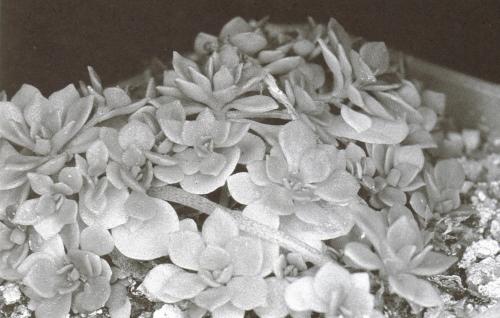Sedum subtile Miquel, 1866 & Sedum zentaro-tashiroi Makino, 1910
Common names : Hime-renge, Ko-mannengusa
Closely related, Sedum subtile and S. zentaro-tashiroi have at times been considered synonymous, but Uhl and Moran (1972) showed the former to have n = 28 and the latter to have n = 17. Both are light green, slender, fairly feeble species. Spathulate leaves of S. subtile are opposite and more obovate, while longer leaves, in whorls of 4 (verticillate), are carried on inflorescences of S. zentaro-tashiroi. Otherwise, the two species are similar vegetatively.
Although both species are made synonymous with S. lineare by Fröderström, vegetatively they are not even vaguely similar. Both are rare in cultivation.

Sedum subtile, winter rosettes in a 3,5-in (9-cm) square pot.
Habitat : Honshu, Shikoku, and Kyushu islands, Japan, are the homes of Sedum subtile, usually on mossy rocks in shaded spots in mountain forests. Sedum zentaro-tashiroi is endemic to Tsushima Island.
Main points of distinction : Leaf shape and arrangement, particularly on inflorescences, are helpful guides to separate the two species that are invariably feeble plants. Narrow sepals are long, free, and unequal, but not spurred. Petals are ephemeral, stamens are short, and carpels are only vaguely spreading.
Variation : Leaves of Sedum subtile are often alternate on inflorescences, and can be whorled in 3s or 5s in S. zentaro-tashiroi.
Horticulture : Both species demand shady spots, regular water, and good drainage without extreme temperatures. Neither is of horticultural importance, but both are bright green subjects for a shady spot.
Ray Stephenson (Sedum, Cultivated Stonecrops, 1994, pp 170 - 171)